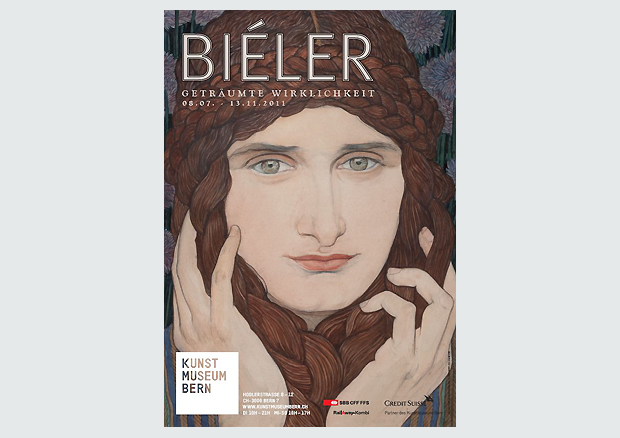Ernest Biéler. Dreamt Reality, 08.07. - 13.11.2011
The Artist – A Valaisan Dandy
In collaboration with the Pierre Gianadda Foundation, the Kunstmuseum Bern is presenting a representative overview of the work of the Swiss artist Ernest Biéler (1863-1948). The show offers the opportunity of not only seeing Biéler’s enigmatic, symbolist figural compositions but also his paintings of simple country life in the Valais region alongside his decorative works. We invite our visitors to rediscover Biéler in an exhibition that revises the artist’s status and demonstrates his significance in international art developments.
Ernest Biéler was born in 1863 in Rolle and grew up
in Lausanne. He studied art in Paris. In 1892 he returned impoverished
to Switzerland and set himself up in Geneva. Up to 1917 he stayed for
longer periods in the French art metropolis, where he cultivated
friendships and exchanged ideas on art with fellow artists. Finally,
however, he settled in the remote town of Savièse (VS) in the Valais
region, where he felt most at home, and in Rivaz on Lake Geneva. Biéler
was a remarkable person and remained an outsider throughout his life.
Even while living in the seclusion of Valais, as a dandy he was not part of the village community and the locals called him “Monsieur le
peintre.”
Biéler’s Significance for Symbolism and Jugendstil
Biéler was an artist who strategically adapted his art to the tastes of various collectors. In Paris he modeled his work not only after fashionable Salon subjects but also experimented with the avant-garde approaches of artists such as
Edouard Manet. His portraits are superbly elegant, demonstrating an
excellent command over painting. Back in Switzerland Biéler specialized
in depicting typical Swiss subject matter. This he found in the village
community of Savièse, still largely unspoiled by civilization. Despite
the fact that Biéler's work is to be found in many museums and private
collections, on account of his Valais pictures his art was long thought
of in terms of clichés. But with his enigmatic symbolist figural
paintings and decorative works he made a significant contribution to
symbolism and Jugendstil on an international level. Biéler also produced numerous public decorative commissions, such as his ceiling painting in the Bern City Theater – or one of the four stained glass windows in the Hall of the Dome of the Federal Parliament Building of Switzerland. In
painting he developed his own personal and technically brilliant graphic style.
A Representative Overview of Biéler's Art and Artistic Domains
With the paintings Les Feuilles mortes (The Dead Leaves, 1899) and Les Sources (The Spring, 1900) the Kunstmuseum Bern owns two key works from Biéler's symbolist
phase. Our comprehensive retrospective not only shows the artist’s early impressionist work in addition to his symbolist and realistic art, but
also his paintings influenced by the Art Nouveau style - the zenith of
his art. With around 120 works, the exhibition reveals both well-known
and obscure facets of the artist. We are also presenting privately owned artworks that will be on show to the public for the very first time.
Our visitors not only have the opportunity of viewing paintings from all the phases in the artist's creative development – additionally they
will find Biéler’s decorative work, chairs designed by the artist, and
his painted ornamentation for a door as well as a secular stained glass
window.
The exhibition is part of the
Leading Swiss Artists series in the Kunstmuseum Bern. It is a
collaborative project with the Pierre Gianadda Foundation, Martigny,
where the exhibition will be on show from December 1, 2011 to February
26, 2012.


